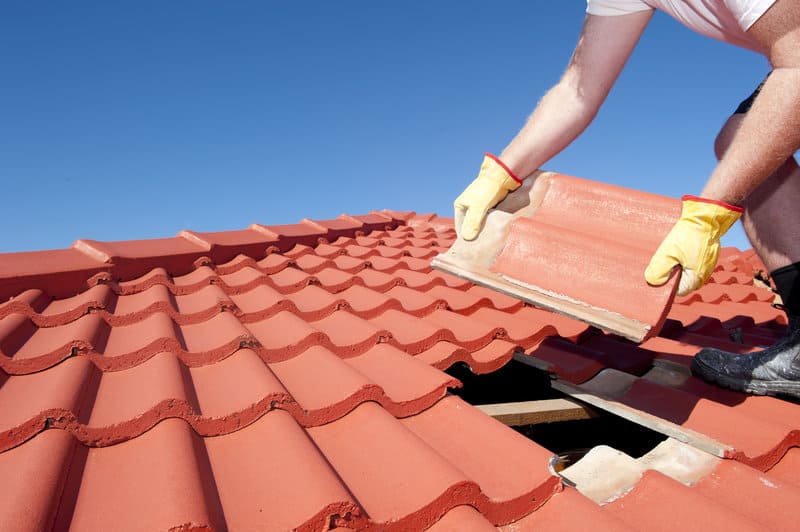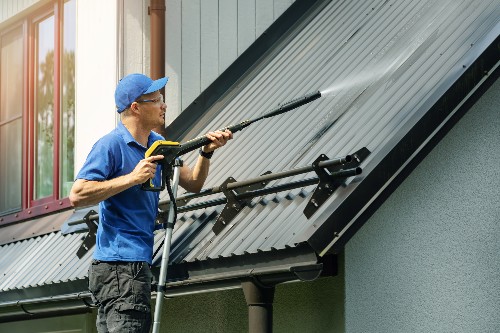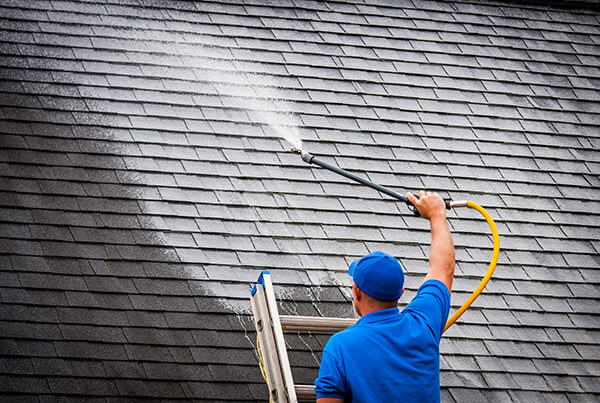Important Tips for Effective Roofing System Maintenance From Leading Roof Professionals
Keeping a roofing system is important for the durability of a home. Leading roofing professionals emphasize the significance of regular evaluations to capture problems early. Additionally, appropriate upkeep practices can avoid pricey fixings down the line. House owners usually ignore basic jobs that add to a roofing system's health and wellness. Comprehending these vital ideas can make a significant distinction. Nevertheless, numerous may wonder what particular strategies are most effective.
Normal Assessments: Trick to Early Issue Detection
Many house owners might forget their roofings, regular inspections play a necessary duty in recognizing potential problems prior to they intensify into costly repair services. An extensive assessment can expose indications of wear, such as missing out on shingles, fractures, or rusted blinking. These relatively small troubles can bring about substantial leakages, architectural damages, or mold development if left unaddressed.
Professionals advise carrying out inspections at the very least two times a year, ideally in the spring and loss. This aggressive technique enables home owners to capture concerns early, guaranteeing the long life of the roofing. Furthermore, after extreme weather occasions, such as tornados or heavy snowfall, an evaluation is important to assess any kind of resulting damage. Routine inspections not just enhance the roof's life-span yet likewise give assurance, recognizing that the home is well-protected. By prioritizing this aspect of maintenance, homeowners can prevent unexpected costs and keep the honesty of their home.
Keep Gutters and Downspouts Clear
Regular upkeep of seamless gutters and downspouts is necessary for avoiding water damage to a home. Blocked rain gutters can cause overruning water, which might harm the roof, foundation, and siding. To preserve peak feature, home owners need to routinely inspect and tidy seamless gutters, specifically during autumn when leaves and debris build up.
Using a tough ladder, people should eliminate any obstructions, assuring that water streams freely through the system. It is suggested to examine downspouts for blockages too; an obstructed downspout can cause water to back up and overflow.
On top of that, house owners must confirm that rain gutters are firmly affixed and effectively sloped to direct water towards downspouts. Mounting gutter guards can also help decrease particles accumulation and decrease maintenance frequency. By keeping gutters and downspouts clear, house owners can shield their building from costly water damages and extend the lifespan of their roof.
Trim Overhanging Branches
To assure the longevity of a roof covering, homeowners should focus on trimming looming branches that posture a danger to their roofing system. Branches can trigger significant damage with various means, consisting of straight get in touch with during storms or hefty winds, which may bring about scrapes or leaks in roof products. Additionally, overhanging branches can facilitate the development of moss and algae, as they supply shade and moisture retention, jeopardizing the roof's integrity.
On a regular basis reviewing the distance in between tree arm or legs and the roof is necessary. Property owners must intend to preserve a secure clearance of at the very least six feet to reduce potential risks. Using expert tree solutions can guarantee secure and proper cutting, avoiding unintentional damages to the home. By proactively managing tree development, house owners can protect their roof coverings, enhancing their life-span and reducing future maintenance costs. Finally, regular branch trimming is an indispensable element of effective roof covering upkeep.
Check for Signs of Damage
Inspecting a roofing system for signs of damages is critical for keeping its architectural integrity and long life (Roof Repair). Homeowners ought to perform visual checks at the very least two times a year, focusing on usual signs of issues. Missing out on, split, or curled tiles can indicate damage, while staining may indicate water damages or leaks. In addition, house owners ought to examine blinking around chimneys, vents, and skylights for rust or gaps, as these locations are prone to leakages
Gutters and downspouts must be free from debris, as obstructions can lead to water merging and subsequent roof covering damage. Interior evaluations are additionally necessary; water discolorations on walls or ceilings might recommend roof covering leakages. Mold and mildew development in attics can indicate extended wetness direct exposure. By routinely examining for these signs of damages, house owners can deal with problems early, avoiding expensive repair work and guaranteeing the roof remains in prime condition.
Preserve Appropriate Ventilation
Proper ventilation is crucial for maintaining a healthy roofing and lengthening its life-span. Adequate airflow prevents wetness accumulation, which can bring about mold and mildew and architectural damage. In addition, readjusting air flow according to the seasons can maximize energy effectiveness and comfort within the home.

Significance of Airflow
While several homeowners may neglect the significance of air movement, preserving proper ventilation is vital for the longevity of a roof. Ample air flow helps regulate temperature level within the attic, preventing warmth build-up that can harm roof products. This guideline likewise adds to energy performance, decreasing the demand for extreme cooling during warm months. Additionally, appropriate air flow aids in distributing air uniformly, reducing the threat of deterioration on roofing parts. Experts recommend mounting vents strategically to advertise a continuous flow of air, which helps in maintaining a perfect environment. Homeowners should focus on air flow when performing roof covering upkeep, guaranteeing that their roof coverings remain useful and intact for years to come.
Avoiding Moisture Accumulation
Maintaining adequate ventilation not only manages temperature level however additionally plays a crucial function in stopping wetness build-up within the attic area. Proper ventilation permits the constant flow of air, which assists to get rid of excess humidity that can collect from different sources, consisting of daily tasks and seasonal modifications. Without click for info adequate airflow, moisture can lead to mold and mildew development, timber rot, and damages to insulation, compromising the structural integrity of the roof covering. Setting up vents, such as soffit and ridge vents, can enhance air circulation, ensuring that damp air is removed while fresh air is pulled in. On a regular basis examining and cleaning these vents is crucial to maintaining their performance, therefore guarding the roof and prolonging its lifespan.
Seasonal Ventilation Modifications
Seasonal modifications substantially affect the air flow requirements of a roofing system. In warmer months, raised temperature levels can catch warmth in the attic room, causing potential damages and higher energy costs. Ample air flow permits warm to leave, advertising a cooler interior setting. On the other hand, throughout colder months, correct ventilation avoids moisture build-up from snow and ice, which can bring about mold and mildew and architectural concerns. Roofing specialists advise changing ventilation systems seasonally, consisting of making use of ridge vents and soffit vents for peak airflow. Normal evaluations need to assure that any type of blockages, such as debris or insulation, are gotten rid of. By maintaining proper ventilation throughout the year, homeowners can secure their roofing systems and boost energy performance.
Clean Your Roof Covering Surface
Cleaning up the roof covering surface is important for maintaining its integrity and prolonging its life-span. A clean roof not only enhances the home's aesthetic appeal yet also prevents the buildup of algae, debris, and moss, which can contribute to damage. Routine cleansing aids to remove impurities that might trap moisture, bring about prospective leaks and architectural damage.
House owners must take into consideration making use of a soft-bristle brush or a stress washing machine with a low setting to gently remove dust and developments from the roof covering. It is necessary to stay clear of extreme chemicals that can damage roof covering products. Additionally, safety precautions ought to be taken; making use of a durable ladder and putting on proper equipment is essential to prevent crashes.

Set Up Professional Maintenances
Routine roof covering maintenance involves even more than just maintaining the surface area tidy; it also needs specialist maintenances to guarantee long-lasting resilience. Involving a qualified roof covering specialist for routine examinations is important, as they can recognize possible problems that might go undetected by the untrained eye. These experts have the competence to analyze the roofing system's condition, inspecting for indicators of wear, damages, or leaks that can escalate right into costly repairs if left unaddressed.
Scheduling these inspections at the very least two times a home year, ideally in spring and fall, helps validate that any type of necessary fixings are performed quickly. In addition, a specialist can advise safety nets to expand the roof covering's life expectancy. Homeowners need to prioritize these evaluations as part of their total upkeep approach, comprehending that timely interventions can protect their financial investment and enhance their home's worth. Ultimately, aggressive treatment through expert services is crucial to attaining a resistant and trustworthy roof.
Often Asked Concerns
Exactly how Frequently Should I Replace My Roof covering?
The frequency of roofing system replacement depends on products and environmental elements. Typically, asphalt shingles last 20-30 years, while steel roof coverings might withstand 40-70 years. Regular assessments help determine the appropriate timing for replacement.
What Are the most effective Materials for Roofing?
The very best products for roof covering include asphalt tiles, steel, slate, and ceramic tile. Each material provides distinct advantages, such as sturdiness, aesthetics, and energy effectiveness, permitting property owners to pick according to their certain requirements and choices.
Can I Execute My Own Roof Repairs?
The concern of executing one's very own roof repair work commonly arises (Roof Repair). While some individuals may have the skills, it is usually advisable to speak with experts to ensure safety and security and appropriate adherence to building regulations and requirements

Just How Do Weather Affect Roofing System Upkeep?
Weather considerably influence roof maintenance. Extreme temperature levels, heavy rains, and snow buildup can trigger damages, while routine evaluations throughout moderate climate warranty timely repair work, preserving the roofing's honesty and extending its lifespan efficiently.
What Is the Typical Life Expectancy of a Roof covering?
The average lifespan of a roofing system varies considerably based on products and environmental factors. Usually, asphalt tiles last around 15 to 30 years, while metal roof coverings can sustain 40 to 70 years with correct upkeep and care.
Several homeowners might overlook Check Out Your URL their roofs, routine examinations play a vital function in identifying prospective concerns before they escalate into pricey repair work. To ensure the durability of a roof covering, house owners should prioritize cutting looming branches that position a threat to their roofing system. By proactively handling tree development, home owners can protect their roofs, improving their life expectancy and lowering future maintenance prices. Examining a roof covering for indications of damage is important for maintaining its structural integrity and long life. While many property owners might ignore the significance of air movement, maintaining appropriate air flow is important for the long life of a roof.